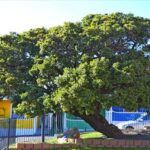The Treaty Tree
The Treaty Tree is a white milkwood (Sideroxylon inerme) tree said to be about 500 years old. You will find it on Treaty Road south of the railway line in Woodstock.
This was Cape Town’s original beachfront. Close by in 1510, the famous Portuguese explorer, Dom Francisco de Almeida, and 64 of his men fought a group of Khoekhoe (local indigenous people) who were armed just with sticks. They attacked and slaughtered the Portuguese, avenging cattle raids, abductions, and extortion
Before the arrival of the Dutch, the tree was a feature of the local landscape. In the early 19th Century the tree was renamed, The Treaty Tree, to commemorate the start of the second British occupation. A peace deal was signed under the tree on 10 January 1806 after the Battle of Blaauwberg. This started the second British occupation of the Cape and it led to the permanent establishment of the Cape Colony as a British possession. Different sources contest whether the treaty was signed underneath the tree or in an adjacent cottage later named Treaty House. However, the latter was demolished in 1935 to make way for a factory,
Until 1834 slaves were sold and convicts hanged under the tree.
The property is owned by The City of Cape Town and the tree was declared a monument in 1967.


